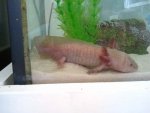helobed
New member
- Joined
- Nov 11, 2010
- Messages
- 144
- Reaction score
- 2
- Points
- 0
- Location
- Melbourne
- Country
- Australia
- Display Name
- Ollie
Well... can anybody tell me what is the difference between "light olive" and "copper" axies, or are they in fact one and the same?
As I see it 'coppers' are in fact T-positive (T for tyronase) albinos; they can't produce melanin, just like a normal albino, but get further along the conversion than 'golden albinos' resulting in a yellowish/red individual but with black eyes and some brown spots.
So my question is, are what we call 'olives' the same as what some call coppers? are they all just T-positive albinos or is there some differentiation between the two? Perhaps are 'olives' just a natural variance in the wild-type phenotype (colour)?
As I see it 'coppers' are in fact T-positive (T for tyronase) albinos; they can't produce melanin, just like a normal albino, but get further along the conversion than 'golden albinos' resulting in a yellowish/red individual but with black eyes and some brown spots.
So my question is, are what we call 'olives' the same as what some call coppers? are they all just T-positive albinos or is there some differentiation between the two? Perhaps are 'olives' just a natural variance in the wild-type phenotype (colour)?


